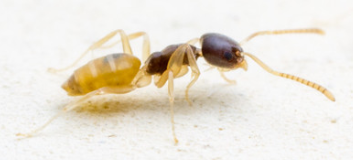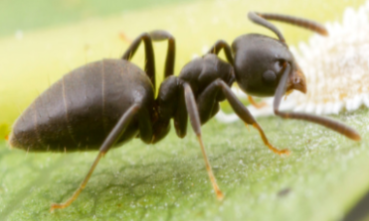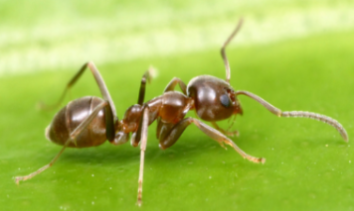Pharaoh ant (Monomorium pharaonis)

(Photo credit to Alex Wild)
The workers are about 1.5 to 2 mm in length, yellowish-brown to reddish-brown with a darker tipped abdomen. The petiole (narrow waist between thorax and abdomen) has 2 nodes. The Pharaoh ant is major indoor species, but may sometimes nest outdoors in tropical regions. Nests are normally found in inaccessible areas, such as in light switches and in cabinets. The infestation of Pharaoh ant normally happens in urban apartment buildings and health care facilities. It may bite, but rarely sting.
Pavement ant (Tetramorium caespitum)

(Photo credit to Alex Wild)
The workers are 2.5 to 3 mm long, the body color ranges from light brown to brown to blackish brown, and the legs are usually light brown. They nest on the soil, under the stones, pavement, and sidewalks. Indoor nests could be noticed in the masonry wall and along the foundation. This species is native to Europe, but it is almost cosmopolitan in urban areas.
Tropical fire ant (Solenopsis geminata)

(Photo credit to Alex Wild)
The workers are 2.4 to 6 mm long and the body color is variable: yellowish-brown, reddish-brown, blackish brown, and combination of light and dark colors. The head of the major worker is enlarged, and more than twice as broad as the pronotum. They nest in the ground with dry or moist soil. The colonies are usually large with only one functional queen. It will cause a painful sting when disturbed.
Hawaiian carpenter ant (Camponotus variegatus)

(Photo credit to Gary Alpert)
Workers measure from 5 mm to 1.27 cm in length and are Hawaii's largest ant species. They are typically yellowish-brown with dark brown stripes across the top of the abdomen. Because of their size and color, winged adults of the Hawaiian carpenter ant are often confused with the winged adults of the West Indian drywood termite and the Formosan subterranean termite, since they tend to swarm at approximately the same time of the year. Although it is primarily found outdoors, the Hawaiian carpenter ant will establish nests in wood that has previously been hollowed out by termites or inside rotting logs and tree stumps. For this reason and because of its name, it is often incriminated as a wood destroyer. Although it may do some excavation of wood, it does not consume wood like termites. They does little to no damage to wooden structures.
Glaber ant (Ochetellus glaber)

(Photo credit to Alex Wild)
The workers are 2 to 3 mm in length. The body is brown in color, but the back of the body is brownish-black, and the mandibles, legs, and antennae are yellow. They are commonly attracted to sweet liquid and food and are often drawn to the kitchen, laundry, and bathroom at home. They naturally nest and forage in trees, feeding on insects, honeydew, and nectar. They can be found nesting in areas such as roof and wall spaces, pot plants, and in-between flat packed items. They may also infest electrical items such as kettles, microwave ovens, and computers.
Crazy ant (Paratrechina longicornis)

(Photo credit to Alex Wild)
The workers are 2.2 to 3 mm long, with a brownish-black head, thorax, and gaster. The body is slender with long legs. The body is covered with long and coarse hairs. The common name of this species is derived from their habit of capable to move rapidly and erratically (instead of following straight line) when disturbed. In the urban environment, they nest indoors in wall voids, and outdoors around buildings. This species do not bite or sting.
Ghost ant (Tapinoma melanocephalum)

(Photo credit to Alex Wild)
The workers are 1.5 to 2 mm long. It has a dark leg and thorax, with a translucent or pale brown gaster and legs. Due to their tiny size and pale color, their presence may be difficult to notice. Indoor nests may be in voids and cavities such as in closets, cabinets, and in discarded clothing. This species do not bite or sting. It will emit rotten, coconut-like odor when disturbed or crushed.
Yellow crazy ant (Anoplolepis gracilipes)

(Photo credit to Alex Wild)
The workers are 4 to 5 mm long, yellow to orange body with long legs and antennae. Yellow crazy ant can easily become established and dominant in a new habitat due to the aggression behavior towards other ant species. It can form large colony size or supercolonies due to the lack of aggression among their own species. This species do not bite or sting. However, they spray formic acid as a defense mechanism to kill the prey.
Big-headed ant (Pheidole megacephala)

(Photo credit to Alex Wild)
The workers are 1.5 to 2.5 mm long, body color is yellowish-brown to dark brown. Colonies contain major workers (with a large head) and minor workers (with a small head). The major workers have large mandibles to help in crushing food. Their large size and extensive tunnels will dominate an area and often eliminate native ant species. They normally nest outdoors, particularly in soil, under the paving stone, or under potted plants. This species is native to Africa, but it becomes a pest in coastal and inland sites in Australia and Hawaii.
White-footed ant (Technomyrmex albipes)

(Photo credit to Alex Wild)
The workers are 3.5 to 4 mm long, and the body is blackish brown to black, and the tarsi (lower part of the leg) are pale yellow. They normally nest around house foundations and invade electrical fixtures. They may also nest in piles of lumber and firewood. The trails are usually along the edges of baseboards and carpeting.
Argentine ant (Linepithema humile)

(Photo credit to Alex Wild)
The workers are 2.2 to 2.8 mm, light brown or brown in color. The body is slender and the head is oval or subtriangular. In urban environment,their nest areas include refuse piles, bird nests, in wall voids, and cracks in the concrete slab. They prefer to nest near to moisture sources such as sinks, water pipes, and potted plants. Colonies are usually large and contain many queens. This species is native to South America.
Elongate twig ant (Pseudomyrmex gracilis)

(Photo credit to Alex Wild)
The workers are 7 to 12 mm long. It is a large and slender species. The head and gaster are dark, while the antennae, mouthpart, and thorax are dark orange. They have large oval eye. They commonly nest in hollow branches, twigs, and stems, as well as in building crevices. Workers have a painful sting but are not aggressive, and generally sting only if trapped under clothing.
Little fire ant (Wasmannia auropunctata)

(Photo credit to Alex Wild)
The workers are 1.5 to 2 mm long. They are yellowish-brown to brown in color and have a darker gaster. They are highly adaptable to many habitats, but prefer shady and moist area. Workers are not aggressive, but have a painful sting, seemingly out of proportion to its size. Recent report has shown that it is widely distributed on Hawaii’s Big Island and have the potential to spread to other neighbouring islands in Hawaii. There are several recent known cases in Oahu. On the Big Island, this species caused serious impact to agriculture by damaging the crops and stinging farm workers during harvesting.
Prevention of Ants
Here are some guidelines to reduce or prevent ant infestation in your home. Most of them aimed to minimize the potential nesting sites for ants and to maintain good sanitation practice to reduce the possibility of ants getting in contact with the food sources.
- Seal the cracks on the wall and floor in your home. Seal the spaces found around pipes and wires in your home.
- Trim the branches and shrubs that touch the surrounding of your home which usually serve as a bridge for the ants to get into homes. This will also reduces the moist shady area beneath them where ants like to nest.
- Inspect the presence of ants if there are any potted plants in the house. Frequently clean up the area.
- Remove trash from your home daily.
- Routinely sweep and mop the kitchen and pantry area.
- Store food and drinks in sealed containers.
Control of Ants
There are several chemical controls used in controlling ants such as surface sprays, space sprays, dusts, and baits. Read carefully and follow the instructions on the label before applying any chemical treatment. It is advisable to consult pest control professionals if you found any ant infestations in your home. A proper ant identification and inspection could result in a more effective treatment and to prevent re-infestations.
References
- Urban Insects and Arachnids: A Handbook of Urban Entomology (2005). William H Robinson. Cambridge University Press.
- Urban Pest Control in Australia (1985). P Hadlington and J Gerozisis. New South Wales University Press.
- NPMA Field Guide to Structural Pests, Second Edition (2007). Eric H. Smith and Richard C. Whitman.